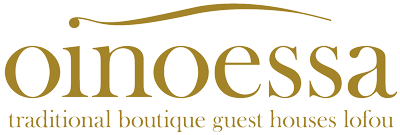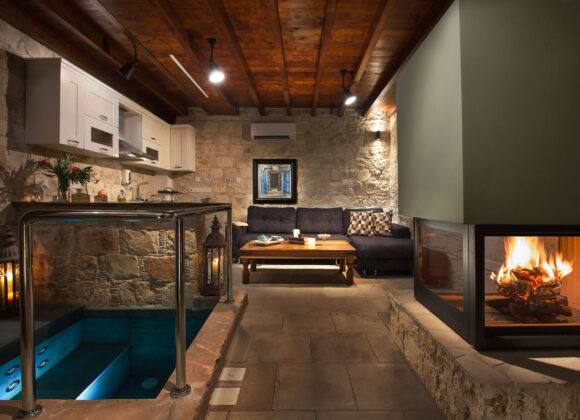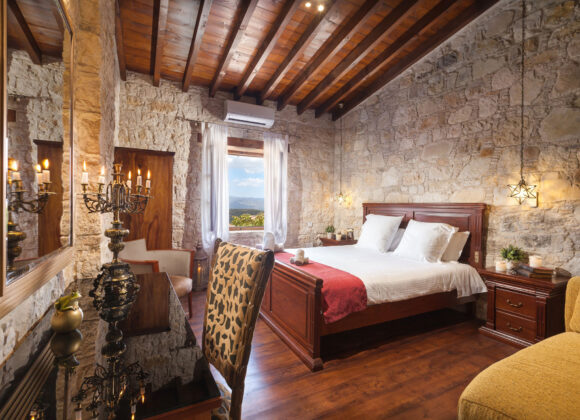About Lofou
About Lofou
Lofou is in the district of ‘Ampelochoria’ villages, around 25 kilometers northwest of the city of Limassol and around 25km from Troodos mountains.
Lofou is built in a circular pattern of hills, at an altitude of 780 meters and has a total of about 650 centimeters in annual rainfall. It is surrounded by mountains with narrow and steep versants. The landscape is divided by two river canals ‘Kryos’ and ‘Kouris’, which both come from the river ‘Kouris’.
Lofou is connected to nearby villages by asphalted lanes. It is connected with ‘Pera Pedi’ village in the North (at a distance of 6.5 km) and from the Southwest with ‘Saint Therapon’ village (at a distance of 4.5 km). From the East side, Lofou is connected with the villages of ‘Sylikou’, ‘Monagri’ and ‘Doros’. Nearby villages are Platres, Omodos, Trimiklini, Vouni and more.
The name Lofou derives from the Greek word ‘lofos’ which means ‘hill’. The original name of the village was “Lofos”. Some residents support that the renaming of the village from “Lofos” to “Lofou” may be attributed to a linguistic change in the everyday language of local farmers. ‘Lofou’ is the name by which the village is nowadays widely known and referred to.
The area must have been inhabited since the Bronze Age. This may be verified by the various archeological findings, particularly by the ancient pots that they were scattered around the area of the village. The dominant view regards that the village must have been founded some years before Cyprus was occupied by the Franks in the late 12th century. During that time, and because of the Ottoman invasions, the locals were forced to abandon the coasts and move to the inner parts of the island in order to find refuge. The location of the village was ideal for their needs since it is hidden in the mountains and, as a consequence, it provided a sense of security. This theory is also supported by Nearchos Kliridis (1961) and J. C. Goodwin (1977).
Primary School
While strolling around Lofou, you will, among others, come across the old Primary School, a beautiful stone built building that used to be vibrant with children’s voices up until 1973. In the school yard there is a bust of Ioannis Stavrianou, a fighter of 1821, as well as a statue of Elias Kannaouros who fell in battle during the Turkish invasion of 1974. Today, efforts are being made by the Ministry of Education and by other organised parties concerned with education for the school building to be exploited. At the same time, most cultural events of the Community and the Association of Expatriates take place in the school yard.
Walking Trail
Lofou walking trail begins just a few meters north of the building area of Lofou towards Sylikou village. It covers a distance of about a kilometer and follows a downhill course towards the traditional faucet of Elitji, where the villagers of Lofou used to get their water in older times. On the faucet, which is at the end of the route, there is an inscription dated 1842, which proves the date that the faucet was built.
The trail is located south of a small stream which flows with water only during the winter months. This phenomenon creates a micro-system along the walking trail somewhat different to the rest of the region. Here the walker may admire various species of Cyprus flora and fauna such as tall shrubs and oaks as well as many herbs.
The walking trail has special aesthetic value for both the residents and the visitors of the village. Many of them usually take the opportunity to visit it in order to relax and escape from the daily routine.
Vineyards
The cultivation of vineyards constituted one of the main occupations of the Cypriots from older times until today, and it was closely connevted with their life, customs and culture. Of course Lofou, as an important wine village of the “ampelochoria” area of the Limassol district, could not be an exception of the rule. The soft climate and the territorial conditions were ideal for the growth of vineyards. The local wine of Lofou was famous all over Cyprus for its excellent quality. It would be remiss not to mention the amazing view of the village in the old times, when the vineyards were blossoming and the green color was prevailing in the horizon.
The Faucet of Elitzi
The ‘faucet of Elitji’ is located approximately one kilometre northeast of Lofou half way towarch Sylikou. The faucet owes its name to the homonymous region. The source that was supplying water the faucet is at the base of a steep mountain. The people of Lofou built a large tank of water in front of the source. The tank is decorated beautifully with big windows, from which the residents of Lofou were getting water. The whole project regarding the construction of the building was completed in 1842. The faucet served the water needs of Lofou residents until 1953, the year in which the British concreted faucets in various parts of the village.
Today visitors may go to the ‘faucet of Elitji’ either from the Lofou – Sylikou rough road, or the walking trail that has been created recently by Lofou Community Council. It is also worth noting that Lofou Community Council has recently constructed a nice patio in front of the ‘faucet of Elitji’, so as to serve the people who visit the faucet and those who enjoy the walking trail.
Kourris Dam
The island’s largest dam, Kouris, on the north west of the southern coastal town of Limassol, has a storage capacity of 115 million cubic metres.
The Cyprus Water Development Department has proceeded to control the outflow of significant amounts of water from the dam, to help enrich the aquifer of Akrotiri, on the southern coast. The dam, whose construction finished in 1988 in the Limassol area, overflowed for the first time in 2004.The views from above the dam are breathtaking.
Agioi Pateres Cave
The chapel of the Holy Fathers in Lofou was built with the initiative of both the Lofou Community Council and the Lofou Ecclesiastical Committee. It is a very small building, measuring just four square meters, and is located northwest of the village, less than a kilometer from the traditional core of Lofou.
In the area where the chapel now stands, was the cave of the Holy Fathers. Pottery and human bones were found inside the cave during the construction of the chapel. In this cave existed for decades a candle, which was lit systematically by the villagers of Lofou.
Although small, the chapel of Holy Fathers is filled with icons of Saints and Fathers of the Orthodox religion. The icons were donated to the chapel by many devoted people of Lofou. The many icons in such a small space create a sense of religious devoutness to the followers. The priest performs community vespers in the chapel once a year in the eve of the feast of the Holy Fathers on the 14th of October.
Hatjiroussos Cave
The ‘cave of Hatjiroussos’ is located in the justifyof the traditional core of the village at the base of a steep hill. It is an impressive perimeter cave with a depth of about 10 meters and a height of about two meters in a total area of about 60-70 square meters. The cave got its name from the homonymous family that first inhabited in its place. It is said that the Hatjiroussos family was the first to reside in the current position of the village of Lofou. This is estimated to have occurred during the Ottoman rule.
Today the cave has been preserved partly by Lofou Community Council. The maintenance work has, however, paused in order for the cave to be scientifically investigated by the Geological Survey Department of the Republic of Cyprus. At first sight, it appears that the ‘cave of Hatjiroussos’ is a monumental place that may be used in order to witness the lifestyle of the people of Lofou in older times.
Folk Art Museum
The Folkloric Museum in Lofou is a private collection of Mr. Petros, a Cypriot who loves his country, culture and tradition. All these items, were collected with much patience and obstinacy. A small but interesting at the same time museum, that you should visit.
Olive press Museum
The Olive Oil Press is located northeast of the church of the village and at a distance of approximately 300 metres. It was manufactured in Lemesos in around the end of the 19th century at “I. Kyriakides & Co Engineering workshop and Foundry”. The word “LEMISSOS” is inscribed with upper case letters on the press.
The building is a rectangular stony construction which consists of two rooms. The first room contained all the means necessary for the production of olive-oil (e.g. the press), while the second room was used as a storage room.
Nowadays, various objects from the olive oil press are still preserved. The stony mill is of course preserved, as well as the millstone, the iron presser and some storage utensils. On the corner of the olive oil press one can admire the “niskia”, which was used to boil water. The pole which was used to push the millstone so that it could crush the olives is also salvaged today.
The olive oil press area has already been restored after efforts were made by the previous Community Council. According to the current Community Council’s short-term plan, the olive oil press will be electrified, while a long-term plan aims at placing all the utensils that were used for the production in one room and place the flourmill, another important piece of machinery from the previous century, into the second room.
Finally, it is worth mentioning that the olive oil press is still owned by the church of Lofou. The reason for that is that the church bought the olive oil press and the olive mill because it used to own a lot of olive trees. The people who took their olives there used to pay the church of Lofou either by using some of their product or in cash.
Panagia Chrysolofitissa Church
Standing on a hill west of Lofou is the main church of the village which is dedicated to the Annunciation of Virgin Mary. The church was constructed in the 19th century. More specifically, the construction of the central building of the church began in 1854 and was completed in 1872. It is a single-roomed church bearing features of gothic art and mainly on its roof. Its floor is covered with small square mosaic marbles with dimensions 20×20. The church is 30.5 metres long and 13 metres and 30 centimetres wide.
The interior of the church is adorned by exquisite hagiographies, an imposing chancel, the despotic throne, the pulpit and the wooden faldstool.
In the church there are old icons of Virgin Mary, one dated back to the 11th century which is located inside the Holy Bema and a second one which, according to Gunnis, is dated back to the 16th century.
Externally, the church is adorned by two bell towers made of stone which were completed at the beginning of the 20th century and more specifically in 1910.
Agios Georgios Chapel
The Chapel of Agios Georgios is built west of the village, near the centre of the village. It is a well preserved chapel which was renovated in the year 2000. The internal part of the chapel is adorned by a large icon of Agios Georgios which was painted by the monks of Mount Athos Kyrillos and Nimfonas. Located next to the church is a large water basin, as well as a cemetery with carven stony graves. What is also worth mentioning is that some of the graves have been classified as Type B Monuments.
Profitis Elias Chapel
Located south of the village, on a height along the road leading from Alassa to Lofou, is a chapel dedicated to Prophet Elias, which has a splendid view of the sea and the water-dam of Kourris. The Chapel of Prophet Elias was renovated in the end of the 20th century and more specifically in 1999. What is noteworthy is that an icon of Prophet Elias painted by hagiographer Othonas Giavropoulos, grandfather of the former president of the Republic of Cyprus Giorgos Vasileiou, is placed on the iconostasis.
Agia Marina Chapel
The chapel of Agia Marina is located 3 kilometres southwest of the village. Its construction began in 1983 and was completed in 1985. Tradition has it that there used to be a deserted monastery where the chapel is located today. To reach the chapel of Agia Marina through the road leading from Alassa to Lofou, which is eight kilometres long, turn left when you reach the fifth kilometre, cross the earth road and you will be led to the beautiful chapel.
Agrino Restaurant
The AGRINO restaurant serves traditional cypriot cuisine full of originality and prepared with wholesome fresh produce. The dining room has a warm atmosphere with cyprus stone flagged floor, stone walls and open fireplace. It opens into the courtyard where breakfast, lunch, drinks and candelit dinners are served in the summer or whenever the temperature allows. The courtyard barbeque kitchen with wood burning oven adds a strong local flavour to the cuisine.
Breakfast features locally baked bread, greek yoghurt, homemade preserves along with seasonal fresh fruits. Light homemade platters and salads are available for lunch. Dinner is a meze of carefully prepared wholesome dishes. After dinner drinks can be served on the TERRACE overlooking the village and surrounding countryside. Wines can be selected from our large collection of mediterranean wines stored in the underground cellar, the STERNA.
Tel: 00357 25813777 – Mob: 0035796 475530
Agrovino Tavern
Costas and his family have been running the taverna for many years and have become a well known right across the region for their delicious cypriot cuisine and their hospitaliy. The Restaurant offers a traditional menu. Open 6 days a week, for breakfast, lunch and dinner. Closed on a Monday.
Tel: 00357 25470202 – Mob: 0035799 468151/ Free WiFi
Kamares Tavern
The Kamares tavern is located in the picturesque village of Lofou and it’s a traditional place, built of stone and decorated with antiques. Enjoy quality food with 18 varieties of appetizers, salads, main dishes with unique and delicious recipes.
Open 6 days a week, for lunch, afternoon snacks, coffee and dinner. Closed on Mondays.
Tel: 00357 25470719, Free WiFi
Agrovino Wine Bar
The Wine bar offers a vast selection of local produced wine as well as pizzas, burgers and cheese platters. Don’t forget to taste the refreshing juices of their own production (e.g. orange, pomegranate, etc).
Tel: 00357 25470202 – Mob: 0035799 468151 – / Free WiFi
- Green Monday (Kathara Deutera) is the first day of lent for the Greek Orthdox – a period which lasts 40 days till Easter. Green Monday is a public holiday in Cyprus and is celebrated outdoors usually in fields, parks or beaches. In Lofou we celebrate it with outdoors activities, music and food, usually at Prophet Elias’ chapel.
- Greek independence day and Annunciation to Virgin Mary (Theotokos). Religious fairs and theater performances take place on this day, 25th of March.
- Dekapentavgoustos festival (assuption of the Virgin Mary) is the highest of the summer with various events and concerts. During this four day festival (15-20/08), more than 10 000 people visit the village from all around Cyprus and other countries as well.
- Palouzes festival is held every penultimate Sunday in September. Everyone can enjoy the fresh-made palouze (made with grape juice) and see the production process, while enjoying traditional music and other Cypriot goods.
Lofou has currently around 100 permanent residents, although many houses operate as weekend and holiday houses. In busy periods such as Christmas, Easter and summer, the population can reach up to 1500 residents.
Our village can provide you with whatever you need during your holiday. The is a small traditional bakery which serves homemade breads and savory, a mini market, a herb shop, coffee shops (traditionally called ‘Kafenedes’) and taverns serving local drinks and “mezedes” (small dishes of Cypriot cuisine). There are also two wine bars, one of which also offers pizzas, pastas, burgers as well as cheese platters. We suggest you call beforehand to make sure they are ready serve you.
You can ask our front desk for more details and/or phone numbers.
The legendary quality of the light early in the morning and late in the afternoon thrills the artists and photographers that visit the narrow stone built paths and valleys, and beguiles those who are visiting just for enjoyment. Calmness is the biggest asset of Lofou, so we suggest you take full advantage of it, in order to leave the village as energized as possible.
Lofou is set about 25 km north-west of the city of Limassol (25 mins drive) and around 25km from Troodos mountains, which is the highest point of Cyprus. Platres village, Koilani, Vouni, Omodos, Trimiklini and Saittas, are only some of the nearby villages (around 15mins drive) that can make your trip even more memorable.
Lofou’s history lies back to the 12th Century, but the entire area has been inhabited since the Bronze age, so it is steeped in history and culture. Its traditional architecture is protected by the Government of Cyprus and that’s why its character remain unspoiled to this date.
Book your cheap flight now from TUI Airways. TUI operates from more than 21 UK airports, direct to over 70 worldwide destinations, including Paphos(PFO) and Larnaca(LCA) airports.



